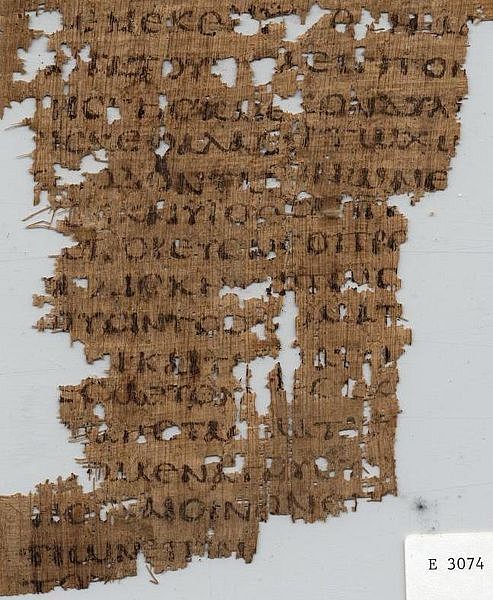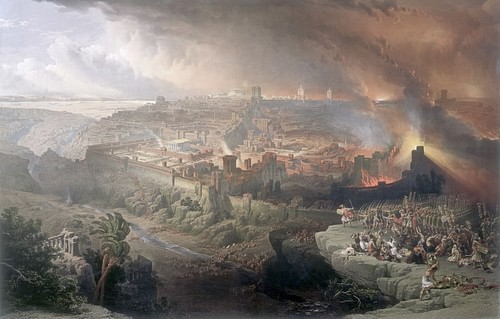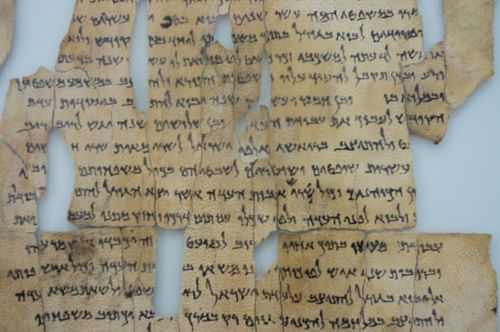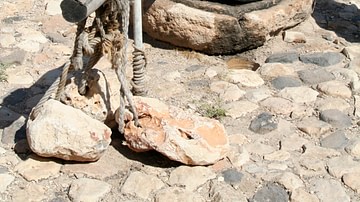
The Book of Amos is a prophetic book of the Hebrew Bible largely dating to the 8th century BCE and considered to be scripture by modern-day Jews and Christians. The work chronicles the visions that the ancient author of this book believed he received from God in order to warn Israel of its impending doom and destruction unless it restores its religious duties to God instead of engaging in the evil and sin that Amos believes has been pervading throughout his country, both in the kingdoms of Israel and in Judah. Naturally, the book also takes place in Israel, as Amos prophesies and preaches to the inhabitants of this land of the judgement of God.
Dating
The Book of Amos is considered one of the earliest biblical books by scholars, as it dates to the middle of the 8th century BCE. Amos informs us that he is writing during the reigns of Jeroboam II and Uzziah, both of whom are biblical kings known from the archaeological record to have reigned from the 8th century BCE. Secondly, Amos states that he is writing two years before a major earthquake (Amos 1.1), an earthquake that has been identified by geologists and known to have devastated Israel somewhere during the middle of the 8th century BCE. Thirdly, in the sixth chapter of Amos (Amos 6.1-2), Amos talks about the destruction of three known ancient cities. These cities are of Calneh, Hamath, and Gath, and are used by Amos to demonstrate to Israel what will happen to them if they do not obey God. The only period in which all three of these cities were destroyed around the same time is c. 900 BCE, and thus Amos was likely writing soon thereafter. According to the scholar Aren Maeir;
It would appear, therefore, that the only viable historical and geopolitical context in which the destruction of Gath, Calneh and Hamath Rabah would be mentioned together would have existed not long after the late 9th century BCE. Later, although Calneh and Hamath continued to be important cities, Gath lost its prominent role. Consequently, one should assume that this passage is to be associated with the original text of the Book of Amos, most consonant with the first half of the 8th century BCE. Attempts to date it to a later stage and to suggest alternative contexts for the reference to these three cities appear to fly in the face of the available historical, biblical, and archaeological evidence. (327-328)
Structure
In the introduction of the book, the author tells us that his name is Amos, as well as that he is a sheep breeder from Tekoa. Interestingly, Tekoa remains a city of Israel to this day. The content of the Book of Amos can be divided into the following structure:
- Introduction (Amos 1.1-2)
- Oracles (1.3-2.6)
- Addressing of Female Samarians (4.1-3)
- Addressing of Rich Samarians (6.1-7)
- Addressing of Rich in Jerusalem (8.4-8)
- Symbolic Visions of Israel's Judgement and Confrontation with Amaziah (7.1-9.8a)
- Epilogue (9.8b-15).
Amos did not believe he was writing in a great time. He believed that he was living in a time of wickedness and he came to the belief that God had given him the duty of preaching to the kingdom of Israel that, if they failed to obey God's commandments and turn themselves from their evil ways, they would be judged by God.
Thus, the majority of modern scholars consider the genre of the Book of Amos to be a prophetic book, many even believing that a specified genre that can unify the entire book and its themes to be a 'covenant enforcement document,' where Amos utilized and developed the law of Moses and its stipulations and punishments in forming the structure and form of his book.
Brief Summary
The Book of Amos is relatively short, spanning nine chapters. It begins with a very short introduction from Amos himself, in which he names the kings reigning over Israel and Judah in his time, and he proceeds to proclaim that it was God himself who has given him the visions of which he is about to declare to Israel and Judah. After this, Amos begins telling us what his deity, Yahweh, has spoken.
At the start, Yahweh declares that he will punish cities like Damascus, Tyre, Ammon, and many others for their sins. The final two regions that Yahweh speaks against are Israel and Judah themselves, because of their lies, their failure to keep Yahweh's commandments, sexual impurity, and several other abominations that Yahweh proclaimed that they committed. Yahweh chastises Israel and Judah, for even though he had corrected and punished them many times beforehand, they refused to return to Yahweh and own up to their mistakes. Rather, they maintained their impure ways, in spite of God's warnings. Then, Yahweh tells Israel and Judah to abandon their evil ways in favor of good and to begin establishing justice in their lands. Yahweh then describes the destruction of the wicked that will occur on the day of the Lord, the day where the Lord is supposed to enter the Earth and judge it, and thereby proceeds to provide Amos with several visions of how God will bring agony and suffering to the wicked in Israel and Judah.

All of a sudden, a figure by the name of Amaziah appears, supposedly a priest of Bethel, who begins telling Amos to go off and prophesy elsewhere, as long as he leaves Bethel, the place of the king's sanctuary. Amos rebukes Amaziah for this, telling him that, because he is trying to stop the prophecy directed to him by God, God will reign destruction on both him and his family. In the entire Book of Amos, Amaziah is the only person who speaks other than God's visions to Amos and Amos himself.
"You have lifted up the shrine of your king,
the pedestal of your idols,
the star of your god—
which you made for yourselves.
Therefore I will send you into exile beyond Damascus,”
says the Lord, whose name is God Almighty. (Amos 5.27-28)
After Amos finishes receiving the visions of how Israel will be annihilated, the book ends on a more promising note. After all this comes to pass, God promises to restore Israel to its old and glorious days, alluding to the time of the monarch and famous king, David.
Historical Background
Because the Book of Amos is a prophetic book and not an ancient history, such as ones that were written by the likes of Herodotus and Thucydides, it contains little recorded history to examine as a background for its events.
Throughout the book, we are given the names of a few kings (Jeroboam, Uzziah, David), a few cities and regions (Calneh, Hamath, Ammon, Gath, Tyre, Damascus, Gaza, Edom, Tekoa, Moab, Israel, Judah, and Bethel), and one solid historical background event (the earthquake of Israel from the 8th century BCE). Besides this general information, little else can be known about the Book of Amos, besides that its author went by the name of Amos, claimed to have been a sheep breeder from Tekoa, and was apparently literate so as to be able to write this book (although he may have had a scribe to assist him, as few sheep breeders were literate at this time). We, unfortunately, know very little about Amos himself, besides being from Judea and that he is today considered one of the minor prophets of the Old Testament, and we have absolutely no idea regarding anything of his friends or family members.
Indeed, because this book was written in the prophetic genre, it is focusing on the morality of Israel and Judah and how the people of these lands need to return to God and Amos focuses on this rather than giving a detailed account of himself or the regions and events of his time, similar to other well-known prophetic writings such as, most comparably, the Book of Revelation from the New Testament. Notably, however, the Book of Amos was included in the canon of the Old Testament very early on, as is attested by its inclusion in the Dead Sea Scrolls, and it is the first ancient writing to use the phrase "day of the Lord." Less than 200 years after Amos prophesied to Israel about their destruction lest they return to God, the king of Babylon, Nebuchadnezzar II, invaded Israel, conquered Jerusalem, and exiled tens of thousands of Jewish peoples to foreign lands.
Conclusion
The Book of Amos is one of the oldest complete books of ancient prophetic writing, one of the books of the biblical canon, and has attracted the attention of innumerable theologians, historians, and commentators. Besides the prophetic genre, the Book of Amos has shown itself to be useful in a variety of ways, as theologians and historians have used the work to discuss and analyze the history of the composition of the biblical texts, the understanding of the minor prophetic books of the Bible, and recently, even the exodus out of Egypt itself. It is no doubt illuminating to both readers, enthusiasts and critics to see how some of the ancient Israelites like Amos regarded morality and evil and how their fellow Israelites and brethren were behaving. For these reasons, one may see there is little surprise as to why Amos became one of the most widely distributed books of its time.







